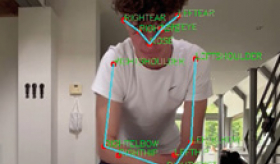
Laurent Baijot's ambition is to reduce the sedentary lifestyle of young people in partnership with various universities. He will be at Belgium House in the heart of the French capital to present a new system combining sport and health. Moov Insights: a 100% Belgian solution developed north of Tournai in collaboration with researchers from the ISIA Lab at UMons, and aimed at both professional and amateur sportsmen and women, health professionals, physical education teachers and also companies wishing to offer their employees a wellness programme.
Laurent Baijot, who previously founded an innovative running application, wants to go even further: ‘We've seen that the level of physical fitness among young people has fallen by more than 30% compared with their parents’ generation. 30 years ago, over a 6-minute run, our parents averaged 13 kph per hour, whereas today our children are doing 9.8 kph. In fact, most 40-50 year-olds are in better shape than 25 year-olds’. The cause? Screens, but also Covid, which has come a long way. Young people sleep less, eat badly and move around far too little.
And the risk? ‘Chronic diseases such as type 2 diabetes are going to develop earlier and earlier in Europe’. This alarming finding has prompted him to collaborate with ADEPS and leading faculties of motor science to ‘propose solutions to curb this sedentary lifestyle’.


Walloon expertise developed in collaboration with the Universities of the Wallonia-Brussels Federation:
U-Mons (cameras and AI, with researcher Sohaib Laraba), UCLouvain (studies to understand the motivations that drive us to continue an activity - sport psychology, prof. D. Brevers), ULB (collaboration with the HUDERF children's hospital and a programme for adolescents suffering from obesity) and studies with secondary schools, with the FSM of ULiège and the Haute Ecole Leonard de Vinci.
At the Olympic Games, visitors to Belgium House will be able to try their hand at 4 tests (balance, flexibility, flexion and coordination) and compare their results with the population of their age and gender in order to assess their level of physical fitness. Just like the Eurofit programme, where young people can enter their data and compare themselves with other young people of the same age and gender. Since 1993, this EUROFIT battery has been carried out every 10 years in Europe, as a barometer of physical health.

For the general public and sports enthusiasts
This innovative digital solution is capable of measuring various parameters of physical fitness (such as coordination, strength, speed and balance), combining a webcam system, Artificial Intelligence (AI) and powerful computers capable of capturing every movement of the human body to establish a precise diagnosis.Depending on the results obtained, the budding sportsperson or professional is then offered a personalised training programme. The idea is to progress with pleasure and without hurting yourself.The future App also features a voice coach to encourage users (e.g. advice on how to speed up or slow down). This is all the more useful as we often tend to run too fast and therefore give up more quickly. Prof. Brevers is currently studying the motivational factors involved in starting and maintaining a sporting activity.
For physical education teachers
With this scheme, ‘the idea is also to give a key role back to physical education teachers in an institutional project. They will be able to follow the pupil over 6 years of secondary school and undertake remedial work and talent spotting by referring young people to sports clubs’.Laurent Baijot knows a thing or two about talent.As a youngster, he had the qualities to become an Olympic runner, but had to give up his dreams because of a lack of quality sports coaching.He trained too much and too hard, like most talented people, but also like most people who want to get back into sport.
For health professionals
Another target audience is healthcare professionals such as physiotherapists, who will be able to monitor their patients during and after their rehabilitation thanks to this digitalization.Raising awareness among the authorities
The aim is also to obtain objective cross-sectional data to engage in dialogue with the authorities and raise their awareness of this public health issue. Obviously, with all the necessary data protection.
The device could be integrated into an application called Moov Insights by the end of the year, in an attempt to improve the physical condition of young people in Wallonia or abroad, or to participate in the project to recruit 8,000 military personnel by 2030 in Belgium.
To raise awareness among the authorities
The aim is also to obtain objective, cross-sectional data to engage in dialogue with the authorities and raise their awareness of this public health issue. Obviously, with all the necessary data protection.
The device could be integrated into an application called Moov Insights by the end of the year, in an attempt to improve the physical condition of young people in Wallonia or abroad, or to participate in the project to recruit 8,000 military personnel by 2030 in Belgium.


And for businesses
Finally, this solution is aimed above all at companies wishing to improve the well-being of their employees and indirectly reduce absenteeism while increasing productivity. In-company workshops, similar to those presented on the Paris stand, can be used, for example, to predict back problems, which are the second most common cause of absenteeism in Belgium and France. Laurent Baijot is also offering workshops on getting back into shape and improving nutrition. Workshops lasting one or more days have already been offered to Airbus employees in France.